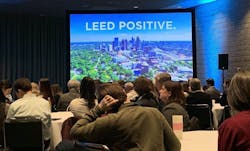The LEED green building rating system will soon recognize regenerative buildings that actively help restore their communities.
USGBC hopes to require all new construction projects to achieve LEED Positive starting in 2025, according to Melissa Baker, senior vice president at USGBC. (Photo: The U.S. Green Building Council premiered LEED Positive at Greenbuild 2020 in Atlanta. Credit: Sarah Kloepple)
“Future versions of LEED must require projects to go beyond efficiency and demonstrate that they're leaving a positive impact on people, the environment and the economy,” Baker explains. “LEED buildings should generate more energy than they use, save more water than they use and remove more carbon than they produce. And have a positive impact on the physical, mental and social health of occupants.”
[Related: 4 Ways to Add Net Zero to Your LEED Certification]
The vision released at Greenbuild includes four key principles for developing LEED:
1. Proposed LEED Positive targets for energy and carbon reduction. The new targets will push the boundaries of new construction and encourage existing buildings with high energy usage to improve their efficiency efforts.
2. Define LEED Positive targets for the other credit categories in the LEED rating system.
3. Continue investment in LEED v4.1 to accelerate LEED’s adoption in new and existing buildings.
4. Support category level performance certificates through the Arc platform, which will provide existing buildings with a pathway toward certification. Projects will be able to earn category performance certificates in each of the five performance categories tracked in Arc—energy, water, waste, transportation and human experience. Achieving higher performance scores across all five categories will allow projects to pursue LEED certification.
USGBC will also launch a Better Materials platform for project teams, Baker adds: “The platform simplifies the LEED review process by allowing project teams to search through thousands of products and materials, access all documentation in one place and identify products that have been pre-verified.” The platform is not yet publicly available but will make its debut soon.
More Greenbuild 2019 coverage:
About the Author
Janelle Penny
Editor-in-Chief at BUILDINGS
Janelle Penny has been with BUILDINGS since 2010. She is a two-time FOLIO: Eddie award winner who aims to deliver practical, actionable content for building owners and facilities professionals.

